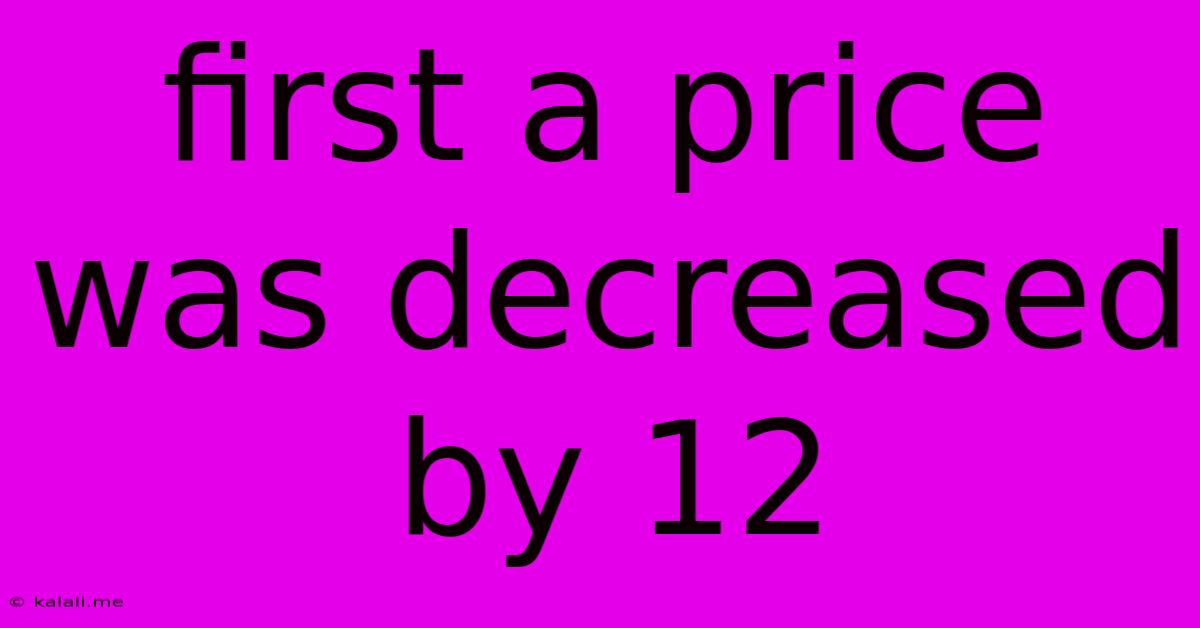First A Price Was Decreased By 12
Kalali
Jun 14, 2025 · 3 min read

Table of Contents
Understanding Percentage Decreases: A Deep Dive into a 12% Price Reduction
This article will explore the implications of a 12% price decrease. We'll cover how to calculate the new price, the practical applications of such a reduction, and the potential impact on consumers and businesses. Understanding percentage changes is crucial in various financial and economic contexts, from budgeting to investment analysis.
What does a 12% price decrease mean?
A 12% price decrease signifies a reduction in the original price by 12% of its value. This is a common scenario in sales, promotions, and economic adjustments. It's important to differentiate between percentage increase and decrease; in this case, we are dealing with a reduction in price. This reduction can be applied to various goods and services, impacting consumer spending and business profitability.
Calculating the New Price After a 12% Decrease
Let's illustrate this with an example. Suppose an item originally costs $100. To calculate the new price after a 12% decrease, follow these steps:
- Calculate the amount of the decrease: 12% of $100 is (12/100) * $100 = $12.
- Subtract the decrease from the original price: $100 - $12 = $88.
Therefore, the new price after a 12% decrease is $88.
This calculation can be simplified using a single formula:
New Price = Original Price × (1 - Percentage Decrease)
In our example: New Price = $100 × (1 - 0.12) = $100 × 0.88 = $88.
This formula works for any percentage decrease, simply substitute the appropriate values.
Practical Applications and Implications
The application of a 12% price decrease is widespread:
- Retail Sales: Businesses frequently use percentage discounts to attract customers and clear inventory. A 12% reduction can be a compelling incentive, particularly during sales events or clearance periods.
- Economic Policy: Governments may implement price reductions on essential goods or services to alleviate economic hardship or stimulate demand.
- Investment Analysis: Understanding percentage changes is vital for analyzing investment returns. A decrease in the value of an investment can be expressed as a percentage loss.
- Financial Modeling: Percentage decreases are integral to financial modeling, used to forecast future values and assess risk.
Impact on Consumers and Businesses
A 12% price decrease can significantly impact both consumers and businesses:
- Consumers: Lower prices increase purchasing power, allowing consumers to buy more goods and services for the same amount of money. This can boost consumer spending and stimulate economic growth.
- Businesses: While a price decrease can attract more customers, it also reduces profit margins. Businesses need to carefully balance the benefits of increased sales volume with the potential loss of profit per unit. Efficient inventory management and cost control are crucial to mitigate this effect. This can also impact pricing strategies in the future, affecting the competitiveness of the product.
Conclusion
A 12% price decrease is a significant factor in various economic and financial contexts. Understanding how to calculate this reduction and its broader implications is essential for consumers, businesses, and anyone involved in financial analysis. By utilizing the formula and understanding the potential impact, informed decisions can be made regarding pricing strategies, budgeting, and investment. Always consider the overall financial picture before implementing or responding to a percentage price change.
Latest Posts
Latest Posts
-
Requirements For University Of North Georgia
Jun 14, 2025
-
Land With Water On Three Sides
Jun 14, 2025
-
What Sport Has The Most Players On A Team
Jun 14, 2025
-
Atoms That Are The Same Form A
Jun 14, 2025
-
Least Common Multiple Of 14 And 20
Jun 14, 2025
Related Post
Thank you for visiting our website which covers about First A Price Was Decreased By 12 . We hope the information provided has been useful to you. Feel free to contact us if you have any questions or need further assistance. See you next time and don't miss to bookmark.